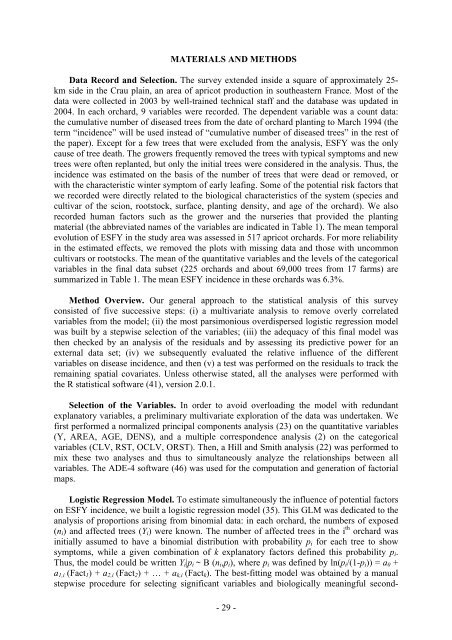Ecole Nationale Supérieure Agronomique de Montpellier ... - CIAM
Ecole Nationale Supérieure Agronomique de Montpellier ... - CIAM
Ecole Nationale Supérieure Agronomique de Montpellier ... - CIAM
Create successful ePaper yourself
Turn your PDF publications into a flip-book with our unique Google optimized e-Paper software.
MATERIALS AND METHODS<br />
Data Record and Selection. The survey exten<strong>de</strong>d insi<strong>de</strong> a square of approximately 25km<br />
si<strong>de</strong> in the Crau plain, an area of apricot production in southeastern France. Most of the<br />
data were collected in 2003 by well-trained technical staff and the database was updated in<br />
2004. In each orchard, 9 variables were recor<strong>de</strong>d. The <strong>de</strong>pen<strong>de</strong>nt variable was a count data:<br />
the cumulative number of diseased trees from the date of orchard planting to March 1994 (the<br />
term “inci<strong>de</strong>nce” will be used instead of “cumulative number of diseased trees” in the rest of<br />
the paper). Except for a few trees that were exclu<strong>de</strong>d from the analysis, ESFY was the only<br />
cause of tree <strong>de</strong>ath. The growers frequently removed the trees with typical symptoms and new<br />
trees were often replanted, but only the initial trees were consi<strong>de</strong>red in the analysis. Thus, the<br />
inci<strong>de</strong>nce was estimated on the basis of the number of trees that were <strong>de</strong>ad or removed, or<br />
with the characteristic winter symptom of early leafing. Some of the potential risk factors that<br />
we recor<strong>de</strong>d were directly related to the biological characteristics of the system (species and<br />
cultivar of the scion, rootstock, surface, planting <strong>de</strong>nsity, and age of the orchard). We also<br />
recor<strong>de</strong>d human factors such as the grower and the nurseries that provi<strong>de</strong>d the planting<br />
material (the abbreviated names of the variables are indicated in Table 1). The mean temporal<br />
evolution of ESFY in the study area was assessed in 517 apricot orchards. For more reliability<br />
in the estimated effects, we removed the plots with missing data and those with uncommon<br />
cultivars or rootstocks. The mean of the quantitative variables and the levels of the categorical<br />
variables in the final data subset (225 orchards and about 69,000 trees from 17 farms) are<br />
summarized in Table 1. The mean ESFY inci<strong>de</strong>nce in these orchards was 6.3%.<br />
Method Overview. Our general approach to the statistical analysis of this survey<br />
consisted of five successive steps: (i) a multivariate analysis to remove overly correlated<br />
variables from the mo<strong>de</strong>l; (ii) the most parsimonious overdispersed logistic regression mo<strong>de</strong>l<br />
was built by a stepwise selection of the variables; (iii) the a<strong>de</strong>quacy of this final mo<strong>de</strong>l was<br />
then checked by an analysis of the residuals and by assessing its predictive power for an<br />
external data set; (iv) we subsequently evaluated the relative influence of the different<br />
variables on disease inci<strong>de</strong>nce, and then (v) a test was performed on the residuals to track the<br />
remaining spatial covariates. Unless otherwise stated, all the analyses were performed with<br />
the R statistical software (41), version 2.0.1.<br />
Selection of the Variables. In or<strong>de</strong>r to avoid overloading the mo<strong>de</strong>l with redundant<br />
explanatory variables, a preliminary multivariate exploration of the data was un<strong>de</strong>rtaken. We<br />
first performed a normalized principal components analysis (23) on the quantitative variables<br />
(Y, AREA, AGE, DENS), and a multiple correspon<strong>de</strong>nce analysis (2) on the categorical<br />
variables (CLV, RST, OCLV, ORST). Then, a Hill and Smith analysis (22) was performed to<br />
mix these two analyses and thus to simultaneously analyze the relationships between all<br />
variables. The ADE-4 software (46) was used for the computation and generation of factorial<br />
maps.<br />
Logistic Regression Mo<strong>de</strong>l. To estimate simultaneously the influence of potential factors<br />
on ESFY inci<strong>de</strong>nce, we built a logistic regression mo<strong>de</strong>l (35). This GLM was <strong>de</strong>dicated to the<br />
analysis of proportions arising from binomial data: in each orchard, the numbers of exposed<br />
(ni) and affected trees (Yi) were known. The number of affected trees in the i th orchard was<br />
initially assumed to have a binomial distribution with probability pi for each tree to show<br />
symptoms, while a given combination of k explanatory factors <strong>de</strong>fined this probability pi.<br />
Thus, the mo<strong>de</strong>l could be written Yi|pi ~ B (ni,pi), where pi was <strong>de</strong>fined by ln(pi/(1-pi)) = a0 +<br />
a1,i (Fact1) + a2,i (Fact2) + … + ak,i (Factk). The best-fitting mo<strong>de</strong>l was obtained by a manual<br />
stepwise procedure for selecting significant variables and biologically meaningful second-<br />
- 29 -



